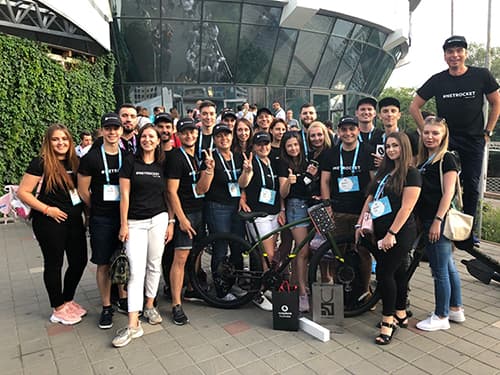SEO Migration When
Redesigning Website: A Case Study
clicks
new leads
impressions
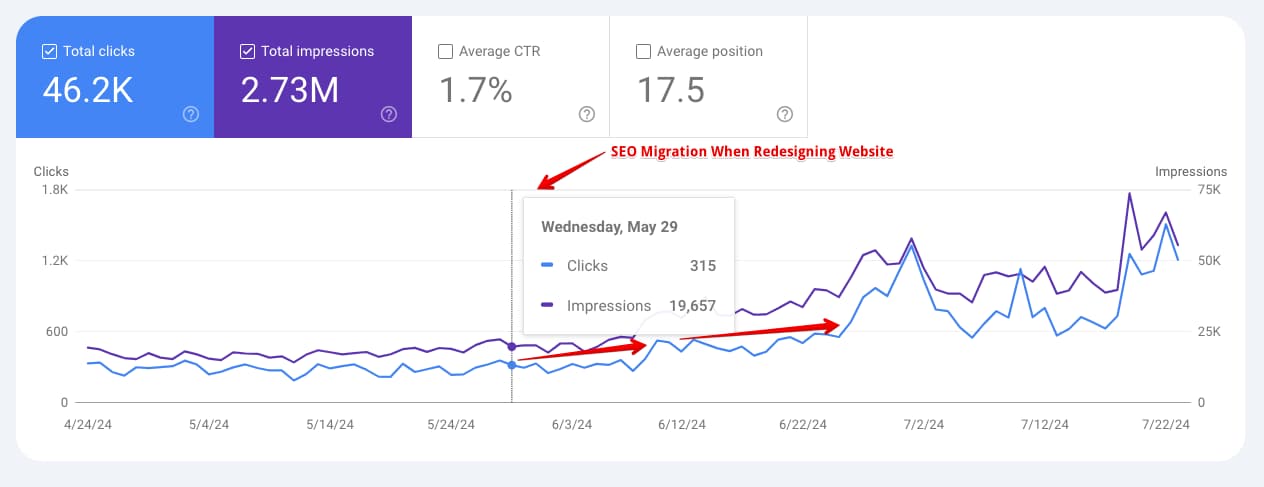
Dynamics of clicks and impressions in GSC before/after migration
About the Project
- Industry: Travel Tech
- CMS: WordPress
- Target Region: EU
- Migration period: June 2024
The project is in aviation and air passenger rights, presented themselves, as trusted partners in the hassle-free compensation process. We’ve been collaborating with our client for the past 20 months, achieving significant milestones together. Now, we’ve reached a crucial stage: redesigning the website. This phase, “SEO Migration When Redesigning Website,” is essential to maintain and enhance the website’s search engine performance during the transition.
Our goal as a WordPress SEO company is to ensure a smooth migration that preserves the site’s SEO value, minimizes traffic disruptions, and leverages the new design to boost overall performance.
The Challenge
As a company that has a huge experience working with WordPress CMS, and obviously having a trump in a face of a WordPress SEO specialist our main goal was to provide a smooth website transition for this client. But of course, it was not without challenges.
Our primary challenge was that the new design would not be launched across all pages simultaneously; only certain types of pages would receive the update initially. This meant that most pages would still retain the old design.
Secondly, the design had already been created, and there were strict timelines for the migration. Therefore, we needed to provide SEO recommendations that would strike a balance and protect against potential traffic drops.
Additionally, the project involved a large team working on the site. All new pages and changes had to be implemented on both the live site and the development version simultaneously.
The partial redesign impacted the entire site, necessitating comprehensive checks. Even after the migration, issues arose that required prompt resolution.
Moreover, the new design included new content blocks that did not exist in the old design, and vice versa. This discrepancy meant that the old content would not always fit perfectly into the new pages, which could potentially affect the rankings and traffic for key pages. However, we successfully navigated these challenges, leading to growth in both rankings and traffic.
So if you are thinking about getting SEO website migration support, we are here for you.
Execution / Optimization Process
During the migration process, we executed these steps:
- alanyzed mockups in Figma;
- checking ready pages on the dev version;
- verifying hreflang, analytics codes, and other critical elements;
- monitored key SEO metrics;
- migration day and ongoing monitoring;
Analyzing Mockups
So we started from analyzing mockups in Figma. It is crucial for SEO because it allows us to identify potential issues and opportunities before the site goes live.
By reviewing the design layouts, we can ensure that SEO best practices are integrated from the start, such as proper header tags, content hierarchy, and internal linking structures.
This proactive approach helps in maintaining optimal site performance and search engine visibility, ensuring that the new design supports rather than hinders SEO efforts.
Testing
The next step involved thorough testing of the ready pages on the development version of the site. This stage is critical to ensure that all SEO elements, such as meta tags, alt texts, and URL structures, are correctly implemented. By identifying and addressing any issues before the site goes live, we can mitigate potential negative impacts on search engine rankings and user experience. This meticulous testing helps in maintaining the integrity of the SEO strategy during the migration and redesign process.
Verifying Key Elements
The next step was to verify hreflang tags, analytics codes, and other critical elements that might have been disrupted during the migration. Ensuring the correct implementation of hreflang tags is essential for maintaining proper language and regional targeting, which directly affects international SEO performance. Additionally, verifying analytics codes ensures that we continue to accurately track user behavior and site performance. By meticulously checking these elements, we can prevent potential issues and ensure a smooth transition, preserving the site’s SEO health and data integrity.
Collecting and analyzing key SEO metrics is essential for gaining a comprehensive understanding of our website’s performance before and after the migration. This process enables us to identify any issues promptly, assess the impact of changes, and make informed decisions to optimize our strategies. By doing so, we can maintain search engine visibility and enhance user engagement, ensuring the website continues to perform optimally throughout and after the migration.
On May 29, the entire team was present to monitor the website’s functionality and ensure optimal performance during the migration. Several SEO checks were conducted throughout the day, and based on these checks, we updated tasks for the developer to address minor technical issues that arose.
Following the migration, we implemented daily monitoring to track organic traffic and conversions. We closely monitored the positions of key keywords and analyzed user behavior on the site using heatmaps and scroll tracking. This ongoing analysis allowed us to quickly identify and address any issues, ensuring the website’s performance remained optimal post-migration.
The Results
Google Search Console

Dynamics of clicks and impressions in GSC before/after migration

Comparison of GSC Data 30 Days Before and After Migration
Clicks: Before the migration, the total number of clicks was 8.49K. After the migration, this number increased to 13.9K. This represents an increase of approximately 63.7%, indicating a significant improvement in user engagement and interaction with the website’s content following the migration.
Impressions: Before the migration, the total number of impressions was 525K. After the migration, this number increased to 923K. This is an increase of approximately 75.8%, suggesting that the visibility of the website in search engine results pages (SERPs) has greatly improved, leading to more opportunities for users to see and potentially click on the website’s links.
Average CTR: The average click-through rate (CTR) slightly decreased from 1.6% to 1.5%.
Average Position: The average position improved from 22.4 to 17.3, indicating better overall rankings in search engine results.
Ahrefs
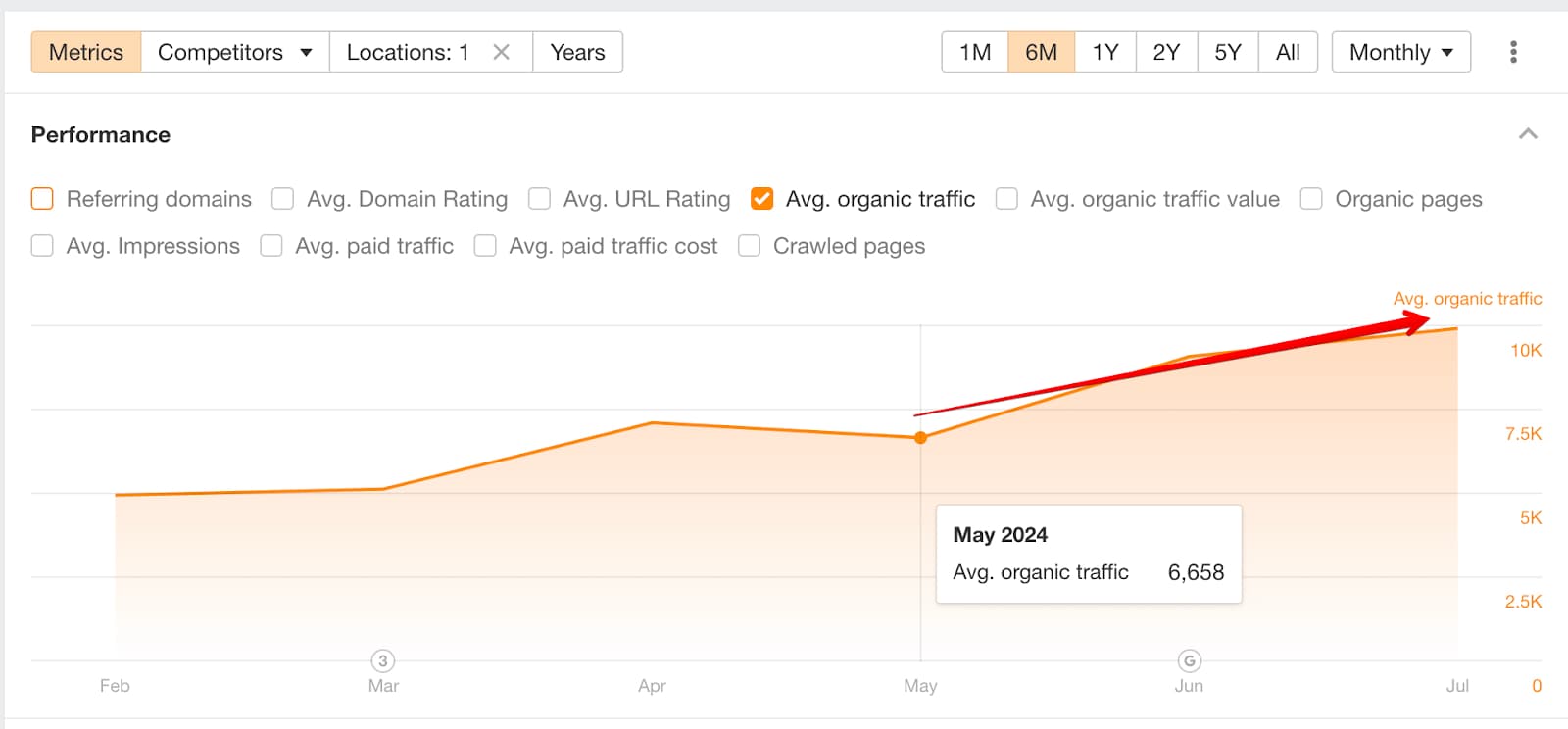
The dynamics of the amount of organic traffic according to Ahrefs after moving
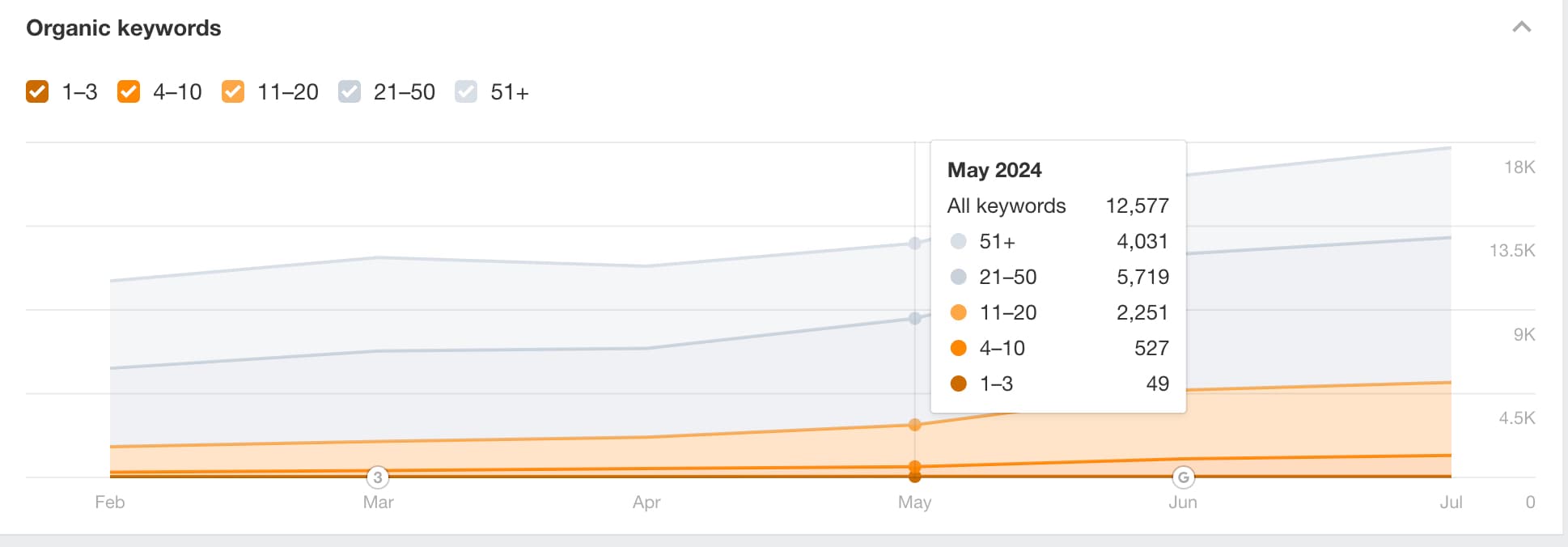
Data on the number of keywords after transition
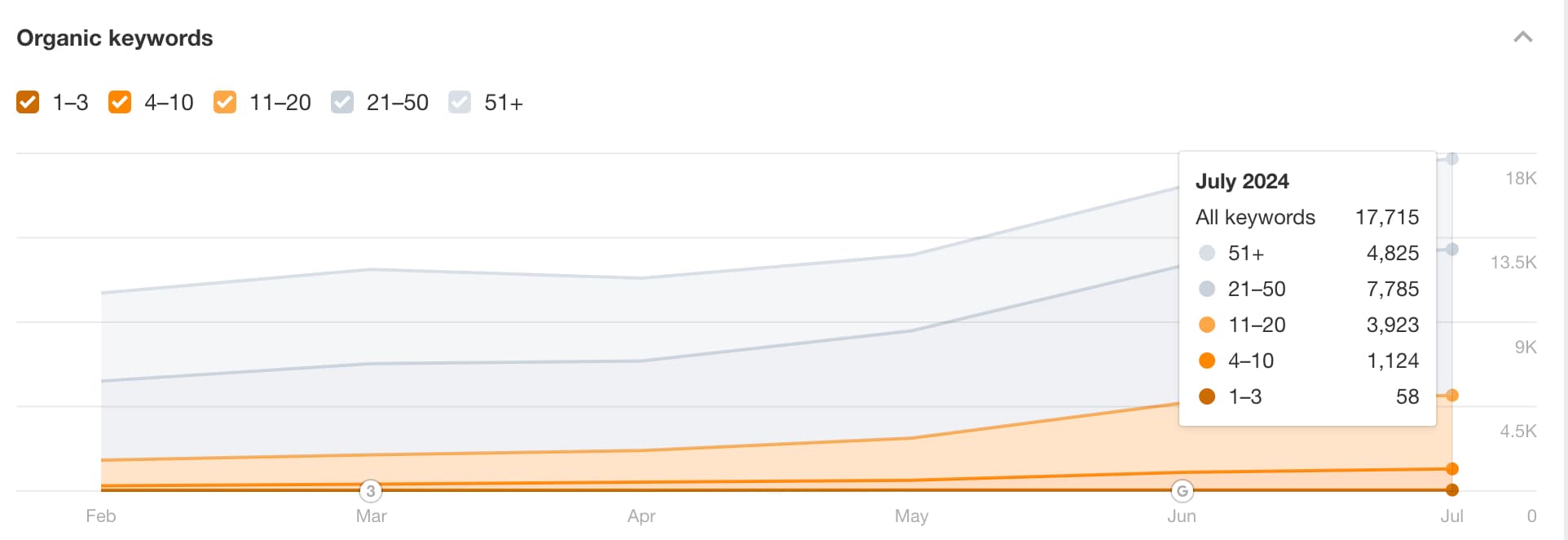
The analysis of keyword rankings from Ahrefs before and after the migration reveals a positive trend in our SEO performance:
- Total Keywords: Increased from 12,577 in May 2024 to 17,715 in July 2024.
- TOP 1-3: Increased from 49 to 58.
- TOP 4-10: Increased from 527 to 1,124.
- TOP 11-20: Increased from 2,251 to 3,923.
- TOP 21-50: Increased from 5,719 to 7,785.
- TOP 51+: Increased from 4,031 to 4,825.
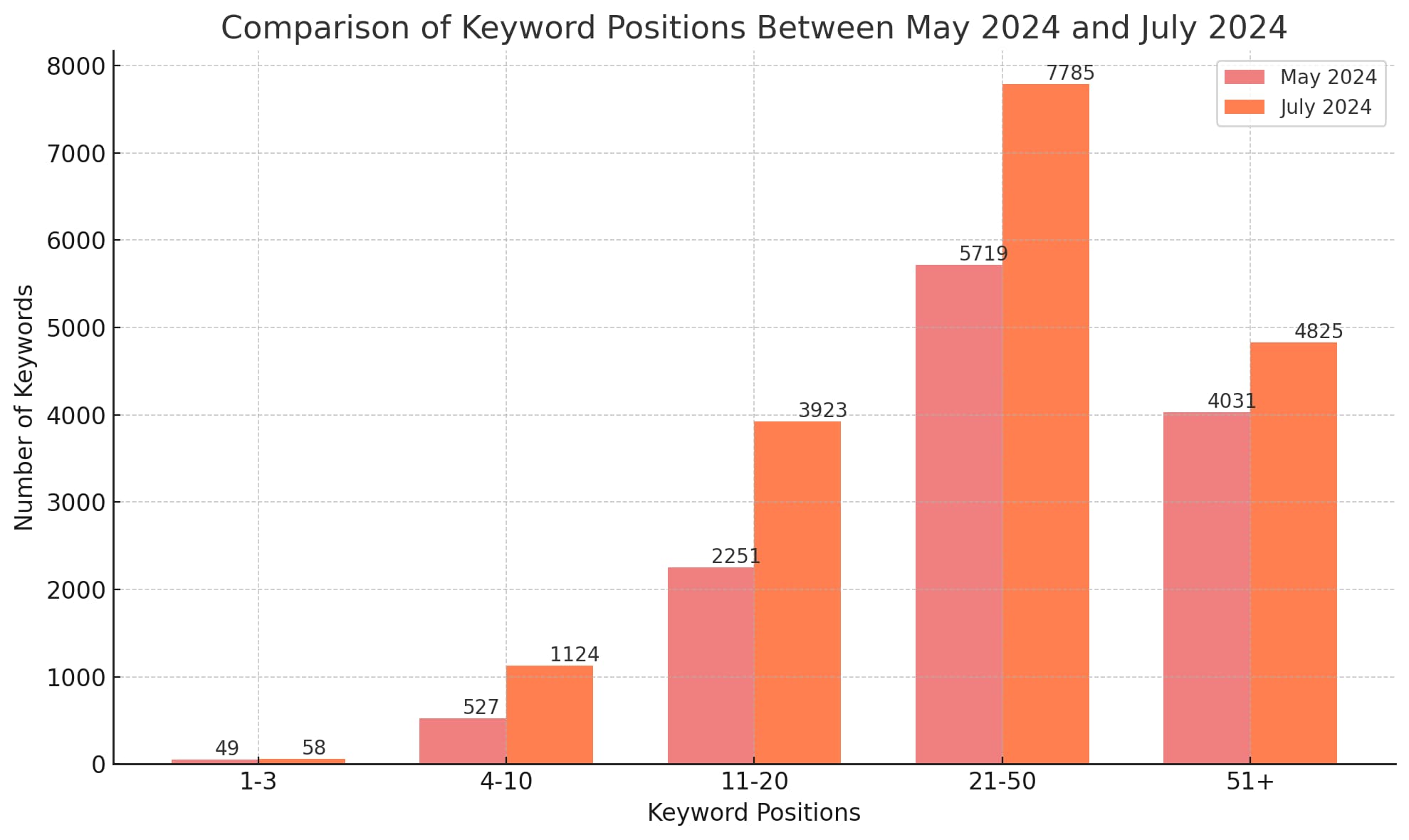
The data clearly shows significant growth in the number of keywords ranking in the top positions, indicating improved search visibility and better overall SEO performance post-migration.
Google Analytics 4
Dynamics of Organic Traffic Based on GA4 Data: 30 Days Before and 30 Days After Migration
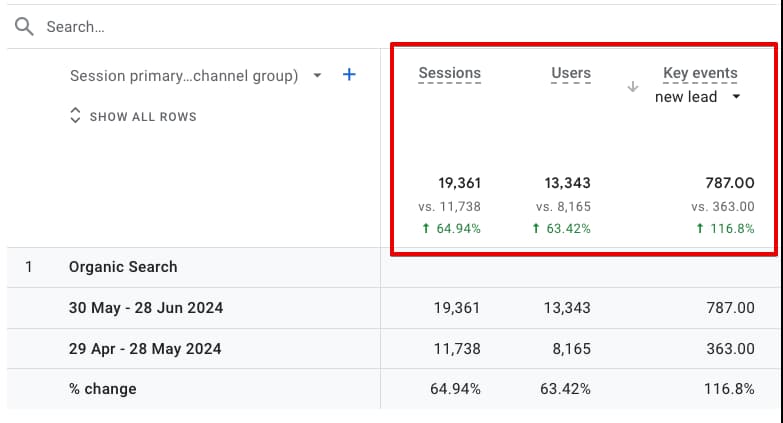
| Metric | Before Migration (Apr 29–May 28, 2024) | After Migration (May 30–Jun 28, 2024) | Change |
|---|---|---|---|
| Sessions | 11,738 | 19,361 | Increased by 64.94% |
| Users | 8,165 | 13,343 | Increased by 63.42% |
| Key Events | 363 | 787 | Increased by 116.8% |
The data from GA4 for the 30 days before and after the website migration shows significant improvements in key metrics.
The number of sessions increased by 64.94%, indicating a substantial rise in user activity.
The number of users grew by 63.42%, showing that more unique visitors are engaging with the website.
Additionally, key events related to new leads saw a remarkable increase of 116.8%, highlighting the improved effectiveness of the website in generating new leads post-migration.
Summary / Conclusion Takeaways
In this “SEO Migration When Redesigning Website” case study, we tried to highlight the comprehensive efforts undertaken to ensure a smooth and successful website migration for our client in the travel tech industry.
Here are a few key achievements and takeaways you can learn from:
- Significant Increase in Clicks and Impressions: The total number of clicks increased by approximately 63.7%, from 8.49K to 13.9K. Impressions saw a remarkable rise of 75.8%, from 525K to 923K, indicating improved visibility in search engine results.
- Improved Average Position: The average search position improved from 22.4 to 17.3, reflecting better overall rankings.
- Positive Keyword Trends: According to Ahrefs data, the total number of keywords increased from 12,577 to 17,715. Notably, the number of keywords ranking in the top 1-3 positions increased from 49 to 58, and those in the top 4-10 positions grew from 527 to 1,124.
- Comprehensive SEO Monitoring: Daily monitoring of organic traffic, conversions, and keyword positions ensured that any issues were promptly identified and addressed, maintaining optimal site performance post-migration.
- GA4 Metrics: The data from GA4 for the 30 days before and after the website migration shows significant improvements in key metrics.
- Sessions: The number of sessions increased by 64.94%, from 11,738 to 19,361. This indicates a substantial rise in user activity and engagement with the website.
- Users: The number of users grew by 63.42%, from 8,165 to 13,343, demonstrating that more unique visitors are engaging with the website post-migration.
- Key Events (New Lead): Key events related to new leads saw a remarkable increase of 116.8%, from 363 to 787, highlighting the improved effectiveness of the website in generating new leads post-migration.
These metrics underscore the success of the SEO migration strategy, showcasing enhanced user engagement, increased visitor numbers, and improved lead generation, all contributing to the overall positive impact of the website redesign and migration.
This case study demonstrates our commitment to delivering effective SEO migration strategies that protect and enhance our client’s search engine performance during a major website redesign. By leveraging our expertise and meticulous planning, we successfully navigated the challenges of the migration, leading to significant improvements in traffic, visibility, and overall SEO performance.
If you doubted the redesign of your website, with the fear of losing the achievements you already have, this case study is a bright example of how you can not only maintain, but also boost your online presence after the migration.
Explore more case studies
Check out our real-life Case Studies, that demonstrating the solid results we’ve achieved for our clients.
Do you want to achieve significant business growth?
